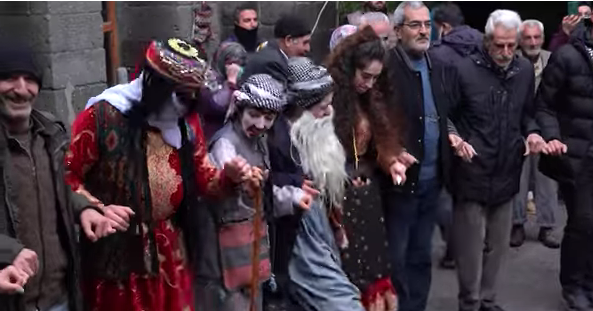Kurdshop- There is a collection of subjects in human beings’ culture that should not be forgotten. Because if they are forgotten the cultural aspect as historical traditions, will be forgotten, too. That is why it is essential that cultural subjects in human history should be preserved in order not to vanish forever. One of these traditions is Kosa Garan (Kosa goes from house to house in this event).
Kosa Garan is an old tradition and in some regions of Kurdistan, it is still popular. Origins of this tradition roots back to the Zoroaster religion and it is still popular among Kurds as a custom, especially for the Yazidi Kurds it is very sacred and is known as the “Khedr Ilyas, the prophet” celebration.
There are two ways to run this ceremonial custom. One of them is at the same time as the Christmas, the birthday of Jesus Christ, and the person who plays the role is called Santa Claus. The other one is carried on at the time of the Kurdish new year, Newroz. In Newroz celebration people celebrate and they call it Kosa Garan. Kurds have had this custom from ancient times as the other nations had their own particular traditions.
On Christmas, Santa Claus goes to people’s houses and gives them gifts.
In Newroz, Kurdish new year, which is the beginning of blessings and happiness, Kosa goes to people’s houses and people give him wheat, bread, sugar, and other foods as a gift and by doing so they hope that the new year blessings and wealth would increase in their homes. Other people follow Kosa, too.
Although nowadays most regions in Kurdistan don’t carry on this custom anymore, but each year in Newroz theatrical plays perform it in a play so that it would not fade away.
At the time of the new year, this tradition will be brought to life by a play. Two men, one plays the role of a woman and the other is Kosa, act like a bride and a groom and they start to play. Based on the story Kosa’s wife is kidnapped, a fight begins, then peace comes back to people’s lives; people invite Kosa into their homes and they give him food and drinks and he gives them gifts, too. According to comments and anecdotes from the elderlies, Kosa Garan was popular from a very old age, and at that time two men had acted the roles and there were no women in this play. There is no particular reason that no woman is playing and even in the old days two men were acting as Kosa and the bride.
In the past when a girl and a boy were in love with one another, the girl would pour some flour on a tray and she would put it on the ground and they would wait for some time. “Khedr Ilyas the prophet” was known for granting wishes. If after some time Khedr Ilyas’s horse footprint would appear on the flour, it meant that their wish would come true.
The Kurds did all these at the beginning of each new year because they believe that when it is the new year the blessing and happiness come with it too. It is probably only a legend but we should not forget that legends were one of the most important aspects of people’s way of thinking that society took it as a belief and they propounded it.
Iranian people celebrate Newroz, too. They also have a similar tradition: “Amoo Nowruz and Naneh Sarma” (Uncle Newroz and Nany Frost).
Since the Kurds are the oldest nation in the area, these traditional customs have originated from their legends and the neighboring nations have adopted them and changed them according to their traditions. There are many other things like Kosa Garan that their roots come from Kurdistan. It is essential that we, as Kurds, know our historical and original cultures, arts, and customs.








